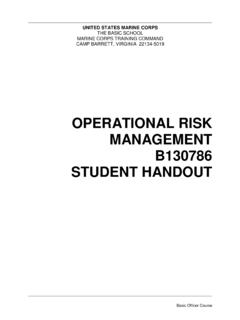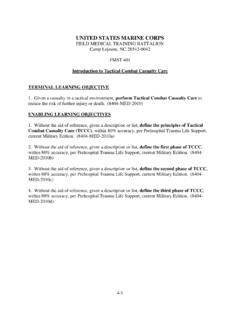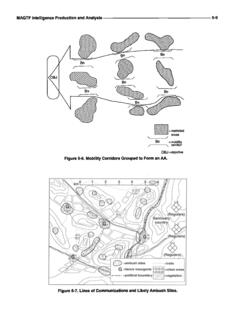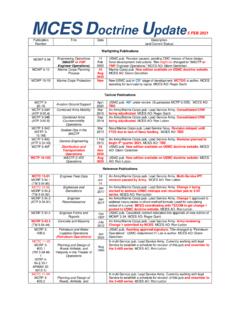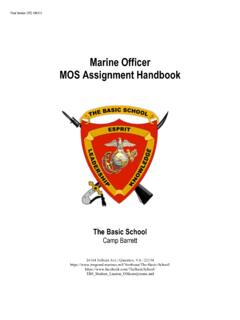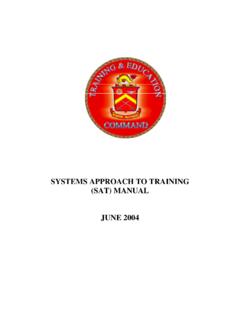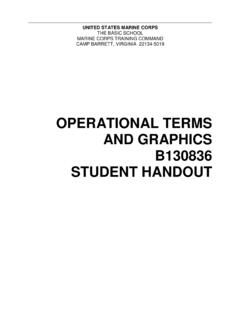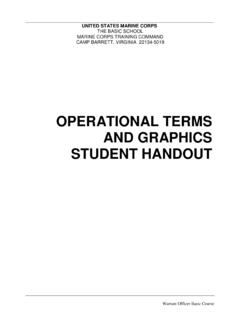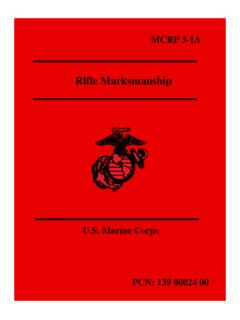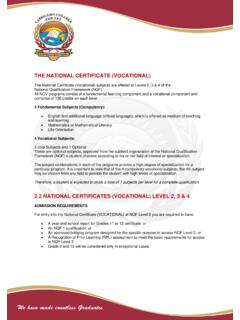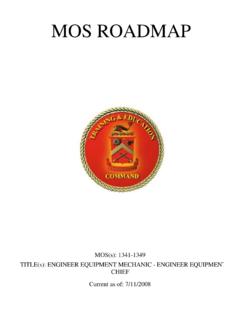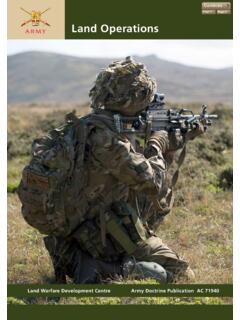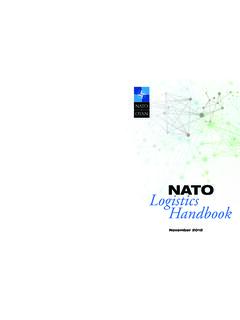Transcription of COMBAT ORDERS FOUNDATIONS B2B0287 STUDENT …
1 UNITED STATES MARINE CORPS THE BASIC SCHOOL MARINE CORPS TRAINING COMMAND CAMP BARRETT, VIRGINIA 22134-5019 COMBAT ORDERS FOUNDATIONS B2B0287 STUDENT HANDOUT Basic Officer Course B2B0287 COMBAT ORDERS FOUNDATIONS 2 Basic Officer Course COMBAT ORDERS FOUNDATIONS Introduction and Importance COMBAT ORDERS instruction at The Basic School (TBS) is a detailed, rigorous package that strives to develop and evaluate your ability to communicate a tactical decision to peers and subordinates in order to execute your plan in a time-competitive environment. The primary focus throughout the instruction and evaluation will be on decisive action, which cannot be achieved in the absence of clearly communicated ORDERS . Prerequisites Keep the following points in mind as you read this handout. MCDP 1 Warfighting, introduced you to the nature of war which is inherently violent and chaotic, which we mitigate through clear communication of intent and simple plans.
2 It discussed maneuver warfare, the theory of which is to strike the enemy s critical vulnerability (the decisive time and place) with massed fires to bend the enemy to our will. In Decision Making, you learned the importance of decisiveness in a time compressed environment, and how that relates to maneuver warfare. This was illustrated by the Boyd Cycle (OODA Loop) in which maneuver in time is achieved through an increased tempo of action. You also learned that as a leader and a Warfighter, you must be comfortable with making reasonable assumptions, supported by fact, to drive your operations. The ability to do this was defined by the 70% Solution. Finally, in Tactical Planning, you learned the Six Troop Leading Steps (BAMCIS) which serve as a guide to design and execute our plan on receipt of higher s plan. You were introduced to the Tactical Though Process, defined as: METT-TC -> EMLCOA -> EXP-> SOM -> FSP -> Tasks and its relation to BAMCIS.
3 Now we will take a look at the process used by higher to communicate higher s decision into tactical action, and how you will utilize higher s communication to plan for and communicate your own decision. Here, we look to go from B to C in BAMCIS. B2B0287 COMBAT ORDERS FOUNDATIONS 3 Basic Officer Course COMBAT ORDERS FOUNDATIONS (Continued) In This Lesson Initially, we shall discuss COMBAT ORDERS fundamentals and FOUNDATIONS . We will also review three types of ORDERS , the required information, and various techniques for effective issue and receipt of COMBAT ORDERS . We shall review some examples that are included at the end of the STUDENT handout. Throughout the lesson, we will relate back to Tactical Planning I, as order development is a key component in the tactical acumen of the officer of Marines. This lesson covers the following topics: Topic Page COMBAT ORDERS fundamentals 7 Types of ORDERS 8 Order Format 11 Techniques for Issuing an Order 25 Summary 27 References 28 Notes 29 Appendix A COMBAT ORDERS Flow Chart 31 B2B0287 COMBAT ORDERS FOUNDATIONS 4 Basic Officer Course COMBAT ORDERS FOUNDATIONS (Continued) Learning Objectives Terminal Learning Objectives TBS-PAT-2002 Given a squad with attachments, a mission with commander's intent, paper, and pen, write a COMBAT order, to support the achievement of higher headquarters intent.
4 TBS-C2-1003 Given subordinate units, a changing situation, and time available, and having previously issued a five paragraph order, issue a fragmentary order, to provide an update to the tactical plan TBS-C2-1002 Given subordinate units, an order, and considering the situation and time available, issue a five paragraph order to communicate a complete, realistic, and tactically sound plan that accomplishes the mission. TBS-C2-1001 Given subordinate units, an order, and considering the situation and time available, issue a warning order, to facilitate concurrent preparation of subordinate unit(s) with reconnaissance and detailed planning. Enabling Learning Objectives TBS-C2-1001a Given a mission from higher, conduct tactical planning for a warning order to determine the likely type of operation. TBS-C2-1001b Given a mission from higher, task organize in a warning order to communicate 5 Ws to subordinates. TBS-C2-1001c Given a mission from higher, develop the situation in a warning order to communicate to subordinates.
5 TBS-C2-1001d Given a mission from higher, develop the mission in a warning order to communicate to subordinates. TBS-C2-1001e Given a mission from higher, develop a tentative scheme of maneuver in warning order to communicate to subordinates. TBS-C2-1001f Given a mission from higher, develop coordinating instruction in a warning order to communicate to subordinates. TBS-C2-1001g Given a developed warning order, disseminate the warning order to communicate the plan to subordinates. TBS-C2-1002a Given an order from higher, conduct tactical planning for an operations order IAW the METT-TC process. TBS-C2-1002b Given an order form higher, task organize in an operationsB2B0287 COMBAT ORDERS FOUNDATIONS 5 Basic Officer Course order to determine 5 Ws for subordinate units. TBS-C2-1003a Given subordinate units, a changing situation, and time available,determine what has changed from the previous order to determine what to communicate to subordinates.
6 TBS-C2-1003b Given an evaluation, describe the characteristics of a fragmentary order without omission. TBS-PAT-2002a Given subordinate units, an order, and considering the situation and time available, write a warning order, to facilitate concurrent preparation of subordinate unit(s) with reconnaissance and detailed planning. TBS-PAT-2002c Given a unit, a mission with a commander's intent, and with supporting and attached units, determine Higher, Adjacent and Supporting mission (HAS), to accomplish the mission and meet the commander's intent. TBS-PAT-2002d Given an order from higher headquarters, paper, and pen, develop commanders intent, to support achievement of higher's mission and includes each of the required items. TBS-PAT-2002e Given an order from higher and a mental estimate of the situation, develop a scheme of maneuver to accomplish the mission. TBS-PAT-2002f Given subordinate units, an order, and considering the situation and time available, incorporate the fire support plan from higher, to develop a complete, realistic, and tactically sound plan that accomplishes the mission.
7 TBS-PAT-2002g Given an order from higher and a mental estimate of the situation, develop coordinating instructions, to accomplish the mission. TBS-PAT-2002h Given an order from higher and a mental estimate of the situation, develop administration and logistics plan, to accomplish the mission. TBS-PAT-2002i Given an order from higher and a mental estimate of the situation, develop command and signal plan, to accomplish the mission. TBS-PAT-2002j Given an order from higher and a mental estimate of the situation, make reconnaissance, to confirm or deny assumptions to accomplish the missionB2B0287 COMBAT ORDERS FOUNDATIONS 6 Basic Officer Course COMBAT ORDERS fundamentals MCRP 5-2A, Operational Terms and Graphics, defines an order as, A communication, written, oral, or by signal, which conveys instructions from a superior to a subordinate. In a broad sense, the term order and command are synonymous. However, an order implies discretion as to the details of execution whereas a command does not.
8 In essence, COMBAT ORDERS express the will of the commander. They must be brief, clear, and definite. A decision, however promising, will fail if the commander cannot effectively communicate it to subordinates. Effective ORDERS planning, writing and delivery allows the commander to effectively communicate and act. The essential thing is action. Action has three stages: the decision must be born of thought, the order or preparation for execution, and the execution itself. All three stages are governed by the will. General Hans Von Seekt In other words, General Von Seekt has identified the importance of Decide, Communicate, and Act. A commander s ability to deliver ORDERS corresponds directly to his tactical skill. If the commander conducts an accurate estimate of the situation and arrives at a definite tactical decision, then he typically issues an effective order. Conversely, a commander who cannot make a decision often will not produce an effective order.
9 Delivering COMBAT ORDERS , like tactical decision-making, is an art. To be effective, commanders must frequently practice making decisions and articulating ORDERS . A competent commander avoids highly formalized formats or lengthy order procedures. They limit his/her flexibility and increase the potential for miscommunication. Often, the commander must individualize ORDERS to best match the abilities of those who receive it. (See Von Schnell s Battle Leadership). A commander will issue a more detailed order to inexperienced or unfamiliar subordinates than to those with whom he/she knows and trusts. Mission tactics are crucial to the art of COMBAT ORDERS . Von Schnell describes them as follows: ..We use what we term mission tactics; ORDERS are not written out in the minute detail, a mission is merely given to the commander. How it shall be carried out is his problem. This is done because the commander on the ground is the only one who can correctly judge existing conditions and take proper action if a change occurs in the situation.
10 There is also a strong psychological reason for these mission tactics. The commander, who can make his own decisions within the limits of his mission, feels responsible for what he does. Consequently, he will accomplish more because he will act in accordance with his own psychological individuality. Give the same independence to your platoon and squad B2B0287 COMBAT ORDERS FOUNDATIONS 7 Basic Officer Course COMBAT ORDERS fundamentals (Continued) There will be situations (such as with less experienced units) where more detailed control is necessary and mission tactics may not be practical. More detailed control is often applied to peacetime live-fire exercises when there is greater emphasis on precision than flexibility. Use mission-type ORDERS whenever the situation allows, but their usage shall not excuse analysis or relax discipline. According to Sun Tzu, speed is the essence of war. ORDERS must be executed in a timely manner.
